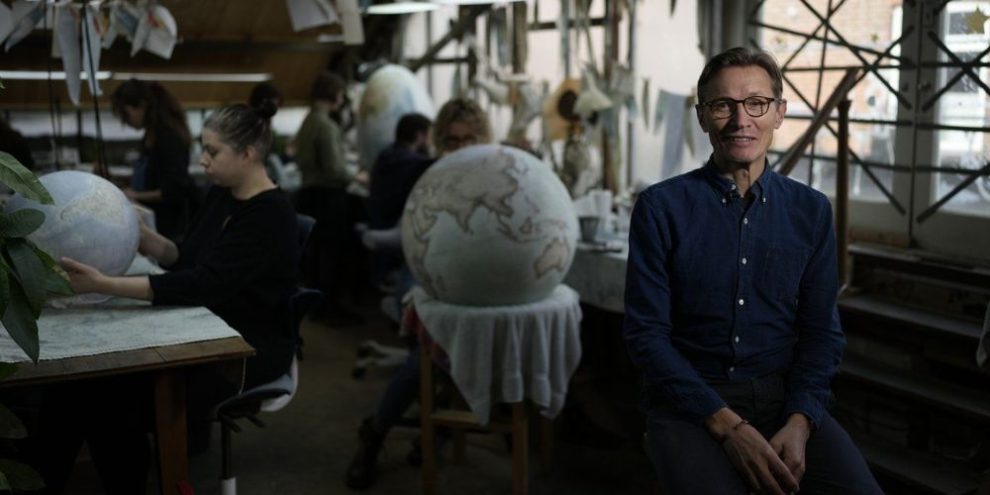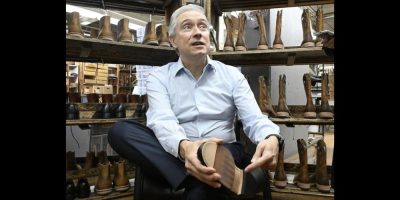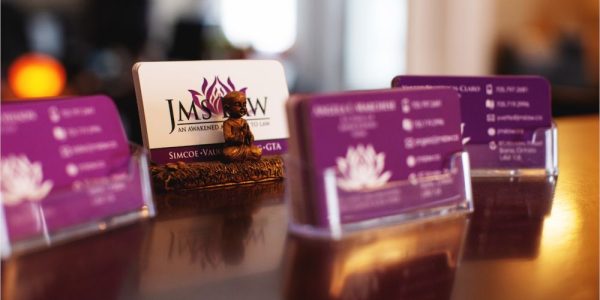
Find a globe in your local library or classroom and try this: Close the eyes, spin it and drop a finger randomly on its curved, glossy surface.
You’re likely to pinpoint a spot in the water, which covers 71% of the planet. Maybe you’ll alight on a place you’ve never heard of — or a spot that no longer exists after a war or because of climate change. Perhaps you’ll feel inspired to find out who lives there and what it's like. Trace the path of totality ahead of Monday's solar eclipse. Look carefully, and you'll find the cartouche — the globemaker's signature — and the antipode ( look it up ) of where you're standing right now.
In the age of Google Earth, watches that triangulate and cars with built-in GPS, there's something about a globe — a spherical representation of the world in miniature — that somehow endures.
London globemaker Peter Bellerby thinks the human yearning to “find our place in the cosmos” has helped globes survive their original purpose — navigation — and the internet. He says it's part of the reason he went into debt making a globe for his father's 80th birthday in 2008. The experience helped inspire his company, and 16 years later is keeping his team of about two dozen artists, cartographers and woodworkers employed.
“You don’t go onto Google Earth to get inspired,” Bellerby says in his airy studio, surrounded by dozens of globes in various languages and states of completion. “A globe is very much something that connects you to the planet that we live on.”
Or, as Scottish-born American explorer John Muir wrote in 1915: “When we contemplate the whole globe as one great dewdrop, striped and dotted with continents and islands, flying through space with other stars all singing and shining together as one, the whole universe appears as an infinite storm of beauty.”
BUILDING A GLOBE AMID BREAKNECK CHANGE?
Beyond the existential and historical appeal, earthly matters such as cost and geopolitics hover over globemaking. Bellerby says his company has experience with customs officials in regions with disputed borders such as India, China, North Africa and the Middle East.
And there is a real question about whether globes — especially handmade orbs — remain relevant as more than works of art and history for those who can afford them. They are, after all, snapshots of the past — of the way their patrons and makers saw the world at a certain point in time. So they're inherently inaccurate representations of a planet in constant flux.
“Do globes play a relevant role in our time? If so, then in my opinion, this is due to their appearance as a three-dimensional body, the hard-to-control desire to turn them, and the attractiveness of their map image,” says Jan Mokre, vice president of the International Coronelli Society for the Study of Globes in Vienna. “Perhaps a certain nostalgia effect also plays a role, just as old cars and mechanical watches still exert a certain attraction on people.”
Joshua Nall, Director of the Whipple Museum of the History of Science in Cambridge, says a globe remains a display of “the learning, the erudition, the political interests of its owner.”
“Sadly, I think globe usage probably is declining, perhaps particularly in the school setting, where digital technologies are taking over,” Nall says. “I think now they’re perhaps more becoming items of overt prestige. They’re being bought as display pieces to look beautiful, which of course they always have been.”
Barrie's News Delivered To Your Inbox
By submitting this form, you are consenting to receive marketing emails from: Central Ontario Broadcasting, 431 Huronia Rd, Barrie, Ontario, CA, https://www.cobroadcasting.com. You can revoke your consent to receive emails at any time by using the SafeUnsubscribe® link, found at the bottom of every email. Emails are serviced by Constant Contact
HOW, AND HOW MUCH?
Bellerby's globes aren't cheap. They run from about 1,290 British pounds (about $1,900) for the smallest to six figures for the 50-inch Churchill model. He makes about 600 orbs a year of varying size, framing and ornamentation.
Creating them is a complex process that starts with the construction of a sphere and progresses to the application of fragile petal-shaped panels, called “gores,” that are fitted together around the sphere's surface. Artists perched around Bellerby's London studio painstakingly blend and apply paint — dreamy cobalt and mint for the oceans, yellow, greens and ochre for the landscape.
The imagery painted on the globes runs the gamut, from constellations to mountains and sea creatures. And here, The Associated Press can confirm, be dragons.
WHO BUYS A GLOBE THESE DAYS?
Bellerby doesn't name clients, but he says they come from more socioeconomic levels than you'd think — from families to businesses and heads of state. Private art collectors come calling. So do moviemakers.
Bellerby says in his book that the company made four globes for the 2011 movie, “Hugo.” One globe can be seen in the 2023 movie “Tetris," including one, a freestanding straight-leg Galileo model, which features prominently in a scene.
And yes, some of the planet's wealthiest people buy them. The family of German tool and hardware company chairman Reinhold Wurth gave him a Churchill, the largest model, for his 83rd birthday. It is now on display at the Museum Wurth 2 in Berlin.
His granddaughter, Maria Wurth, says in an Instagram video that the piece highlights the history of the company and the magnate's travels.
A ‘POLITICAL MINEFIELD’
There is no international standard for a correctly drawn earth. Countries, like people, view the world differently, and some are highly sensitive about how their territory is depicted. To offend them with “incorrectly” drawn borders on a globe is to risk impoundment of the orbs at customs.
“Globemaking,” Bellerby writes, “is a political minefield.”
China doesn't recognize Taiwan as a country. Morocco doesn't recognize Western Sahara. India's northern border is disputed. Many Arab countries, such as Lebanon, don't acknowledge Israel.
Bellerby says the company marks disputed borders as disputed: “We cannot change or rewrite history."
SPEAKING OF HISTORY, HERE'S THE ‘EARTH APPLE’
Scientists since antiquity, famously Plato and Aristotle, posited that the earth is not flat but closer to a sphere. (More precisely, it's a spheroid — bulging at the equator, squashed at the poles).
No one knows when the first terrestrial globe was created. But the oldest known surviving one dates to 1492. No one in Europe knew of the existence of North or South America at the time.
It's called the “Erdapfel,” which translates to “earth apple” or “potato." The orb was made by German navigator and geographer Martin Behaim, who was working for the king of Portugal, according to the Whipple Museum in Cambridge. It contained more than just the cartographical information then known, but also details such as commodities overseas, market places and local trading protocols.
It's also a record of a troubled time.
“The Behaim Globe is today a central document of the European world conquest and the Atlantic slave trade,” according to the German National Museum's web page on the globe, exhibited there. In the 15th century, the museum notes, "Africa was not only to be circumnavigated in search of India, but also to be developed economically.
“The globe makes it clear how much the creation of our modern world was based on the violent appropriation of raw materials, the slave trade and plantation farming," the museum notes, or “the first stage of European subjugation and division of the world.”
TWIN GLOBES FOR CHURCHILL AND ROOSEVELT DURING WWII
If you've got a globe of any sort, you're in good company. During World War II, two in particular were commissioned for leaders on opposite sides of the Atlantic as symbols of power and partnership.
For Christmas in 1942, the United States delivered gigantic twin globes to American president Franklin Roosevelt and British Prime Minister Winston Churchill. They were 50 inches in diameter and hundreds of pounds each, believed to be the largest and most accurate globes of the time.
It took more than 50 government geographers, cartographers, and draftsmen to compile the information to make the globe, constructed by the Weber Costello Company of Chicago Heights, Illinois.
The Roosevelt globe now sits at the Roosevelt Library in Hyde Park, N.Y., and Churchill’s globe is at Chartwell House, the Churchill family home in Kent, England, according to the U.S. Library of Congress.
In theory, the leaders could use the globes simultaneously to formulate war strategy. “In reality, however," Bellerby writes, “the gift of the globes was a simple PR exercise, an important weapon in modern warfare.”











